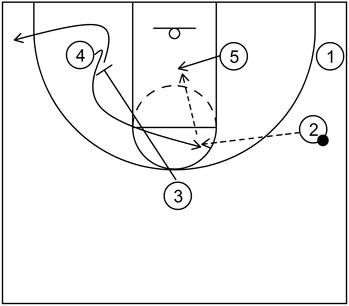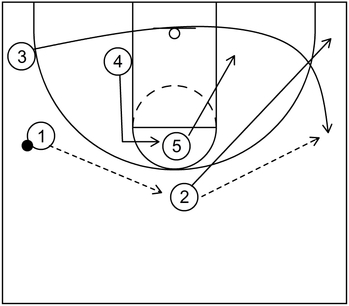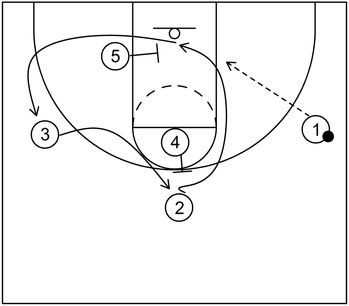What is the high low action in basketball
The high low action is a tactic within the game of basketball that occurs when an offensive player, typically near the high post or top area of the court, passes the ball to another player who is around the basket inside of the lane or within the general vicinity of the low post area, ultimately to create a high percentage scoring opportunity.
Which players typically execute the high low action
The high low action is typically executed by the power forward, generally as the high post player, and the center, generally as the low post player.
However, it is also possible to execute the high low action with the center as the high post player while the power forward plays near the low post.
Furthermore, the high low action could be utilized by the other basketball positions, particularly the shooting guard or small forward, near the high post or low post areas. Having said that, implementing high low with those secondary positions is less common against man to man defense but could be a more viable option against zone defenses.
What are the general techniques for executing the high low action
Technique #1
The first technique for executing the high low action is for the play initiator, usually the point guard, to pass the ball to the offensive player near the high post.
Also, in some instances, this initial pass could be given to a player at the top, such as with pick and pop action as mentioned previously.
Technique #2
The second technique for executing the high low action is for the offensive player near the low post area to cut into the lane, in front of the basket.
Also, if the defender is generally playing behind the offensive player near the basket, then that same offensive player can execute a duck in and seal move in the lane before receiving the ball.
When that duck in and seal occurs, the defender will not be able to effectively contest or alter the low post player’s shot attempt.
However, if the defender is fronting the offensive player near the basket in an effort to prevent that same player from easily receiving the ball, then the offensive player near the high post (or at the top behind the three-point line) could execute a pass over the hands of the defender to the player near the basket.
Afterwards, the player near the basket receives the ball and attempts to score with a close-range shot such as a layup, dunk, or hook shot.
Why is the high low action generally effective
Player isolation near the basket against man to man defense
The high low action is generally effective, particularly against man to man defense, because there is only one offensive player, typically a low post player, near a low post block.
At the same time, there is another offensive player that plays at the high post area while the other three offensive players are usually located near the perimeter areas at the top, wings, or corners.
When that occurs, the offensive team is able to isolate a player near the low post block. If that same isolated player happens to be the team’s best low post player, then this could be very beneficial for the offensive team.
From that point, the isolated player near the low block (usually a low post player) could cut into the lane, receive the ball from the high post player and then score (generally with a low post move) near the basket without needing to worry about potential help defense.
Furthermore, if the defensive team does happen to send help, it would most likely be ineffective because the high low action generally provides adequate spacing between the offensive players.
In other words, the offensive player near the basket should be able to execute a field goal attempt prior to the help defense arriving in time.
Moreover, even if the help defense is able to arrive in time, then the player with the ball near the basket could simply pass it back out to the perimeter or high post area, depending on whichever other player is open.
Afterwards, at least one of those players will usually be open for a possible jump shot.
Attack gaps against zone defense
The high low action can also be effective against certain zone defenses, particularly zones in which the high post area is open.
Essentially, if an offensive player is able to cut from a high area or flash from a low point into the gaps near the high post (i.e. the weak spot) of certain types of zones, then high low action could get executed afterwards.
In other words, if an offensive player is able to get into the high post of certain zone defenses, then another offensive player near the low post area (or in some instances, the short corners) could cut into the lane, receive the ball, and then score near the basket.
Even though there is usually more than one defender near the basket in the case of zones, this is generally different than help defense from the man to man action.
Basically, the zone defenders cover areas and typically, only one of those defenders will cover the area near the basket.
Therefore, an offensive player near the basket still should be able to execute a field goal attempt by way of the high low action.
What are basic examples of high low set plays
Set Play – Example 1

This is an example of the high low action from a 1-4 low set play. To begin, 1 dribbles toward the left side wing area via the on-ball screen set by 4.
Next, 4 pops out near the top and receives the ball from 1. From that point, 5 could cut into the lane, receive the ball from 4, and score near the basket to complete the high low action.
Set Play – Example 2 – Part 1

This is an example of the high low action derived from the Hawk set. To start, 1 executes a dribble entry towards the right side wing area.
Afterwards, 2 cuts to the basket and could receive the ball from 1 if that is open. If it is not open, then 4 receives the ball near the top while 2 cuts through to the right side corner.
Set Play – Example 2 – Part 2

Next, 3 cuts to the left side wing via the down screen set by 5. Following the screening action, 5 can open up in the lane, receive the ball from 4, and score near the basket.
Also, as an alternative option, 3 could also receive the ball from 4 and take the jump shot if open.
Furthermore, as another scoring option, 2 could cut to the right side wing via the wide pin down screen set by 1, receive the ball from 4, and take the three-point shot if open.
Set Play – Example 3 – Part 1

This is an example of high low action with elements derived from the triangle offense.
To demonstrate, 3 receives the ball from 1 and then, 1 executes an outside cut to the right side corner to form the sideline triangle.
Also, when 1 executes the cut after passing the ball, 2 fills the top area near the three-point line.
Following that, 5 could receive the ball from 3 and afterwards, 5 could score with a low post move if that is available.
Set Play – Example 3 – Part 2

If 5 is not able to execute a low post move, then 2 cuts to the right side wing via screen away and post split action of 3.
After that, 2 receives the ball from 5 while 3 fills the vacated area at the top. Additionally, if 2 is open after receiving the ball, then 2 can take the jump shot.
Set Play – Example 3 – Part 3

If 2 is not open after receiving the ball, then 4 could cut to the high post area via the down screen set by 3. Also, after setting the screen, 3 cuts through to the left side corner.
Next, 4 receives the ball from 2 and could take the mid-range jump shot if that is open. Otherwise, 5 could cut into the lane, receive the ball from 4, and then score near the basket to finish the high low action.
Affiliate Disclosure: I may earn a commission on qualifying purchases made through the links below.
What are basic examples of high low continuity offense
Continuity – Example 1 – Part 1

This is an example of a continuity high low set primarily focused on getting the ball to the team’s low post players.
The set begins in the 1-4 high formation and it is derived from High/Low Motion Offense Sets with Special Situations by Steve Forbes.
To start, 2 receives the ball from 1 and after that, 1 cuts to the strong side corner. Next, 5 cuts to the right side low post block via the high cross screen set by 4.
From that point, 5 could receive the ball from 2 and score near the basket.
Continuity – Example 1 – Part 2

If 5 is not open, then 4 could receive the ball from 2 instead. Once that occurs, 5 could cut into the lane, receive the ball from 4, and score near the basket to achieve the high low action.
If 5 is still not open, then 5 could cut across to the left side low post area while 3 receives the ball from 4.
Continuity – Example 1 – Part 3

Next, 5 could receive the ball from 3 and attempt to score via a low post move. Otherwise, 1 could cut to the top and receive the ball via the stagger screens set by 2 and 4.
Afterwards, 1 could take the jump shot if open. Additionally, after the screens are set, 2 fills the right side corner while 4 cuts to the right side low post block.
Continuity – Example 1 – Part 4

If 1 did not take the jump shot, then 2 could get open with a V-cut and receive the ball from 1 via ball reversal action.
From there, 1 cuts through to the left side corner while 5 executes an L-cut to the high post area.
Continuity – Example 1 – Part 5

After those cuts, 5 could receive the ball from 2 and execute the high low action with 4 near the basket. If 4 is not open, then 1 could receive the ball from 5 after receiving the wide pin down screen set by 3.
At the same time, 4 cuts to the left side low post block. From that point, 1 could take the open jump shot or pass inside to 4 who could score near the rim.
Additionally, 2 could cut back to the top for defensive balance or as a part of the continuity set up shown in the next diagram.
Continuity – Example 1 – Part 6

This is an example of how the full continuity could be executed again. 2 receives the ball from 1 and as that happens, 3 cuts through to the right side wing area.
Next, 3 receives the ball from 2 while 5 cuts down to the right side low post and 4 executes the L-cut to the high post. Additionally, 2 would cut through to the right side corner.
From this point, 3 would pass to 5 near the basket or 4 near the high post and the continuity action would keep going as before.
Continuity – Example 2 – Part 1

This is an example of a continuity high low set derived from the UCLP Missile Offense by Tyler Whitcomb.
To start, 3 receives the ball from 1 and then, 1 cuts to the basket via the back screen set by 4. After that, 1 could receive the ball again from 3 if that is open.
If 1 is not open, then 1 continues the cut out towards the right side wing via the baseline screen set by 5. At the same time, 2 cuts toward the high post and then pops out to the top.
Continuity – Example 2 – Part 2

Next, 2 receives the ball from 3 and then swings it to 1. As that happens, 5 cuts away from the ball to the left side low post block. The next portion of diagrams show the continuity followed by a high low option.
Continuity – Example 2 – Part 3

To begin again, 2 cuts to the basket via the back screen set by 4. If 2 is open on the cut, then 2 could receive the ball from 1.
Otherwise, 2 could cut through to the left side wing via the baseline screen set by 5. Also, as that action occurs, 3 cuts toward the high post area and then pops out to the top.
Continuity – Example 2 – Part 4

Next, 3 receives the ball from 1 and then 2 receives the ball from 3 to complete the ball reversal. Also, as that occurs, 5 cuts away to the right side low post block.
From there, 4 receives the ball from 2 and then 5 cuts into the lane. Afterwards, 5 could receive the ball from 4 and score near the rim to finish the high low action.
What is an example of high low zone offense

This is an example of high low action against a 2-3 zone defense. It also begins with a 3 out 2 in formation but the post players set up near the short corners as opposed to the low post blocks.
To demonstrate, 3 receives the ball from 1 near the left side wing and immediately swings it back to 1. The main purpose of that action is to simply shift the zone.
Following that, 2 receives the ball from 1 and on the air time of that pass, 4 flashes to the high post area near the right side elbow.
From there, X1 will most likely closeout to prevent an open jump shot from 2. Therefore, 4 could receive the ball from 2 in the gap behind X1.
Next, 4 could take the mid-range jump shot. Alternatively, if X5 attempts to closeout to prevent the mid-range shot, then 5 could cut into the lane, receive the ball from 4 and score near the basket to accomplish the high low action.